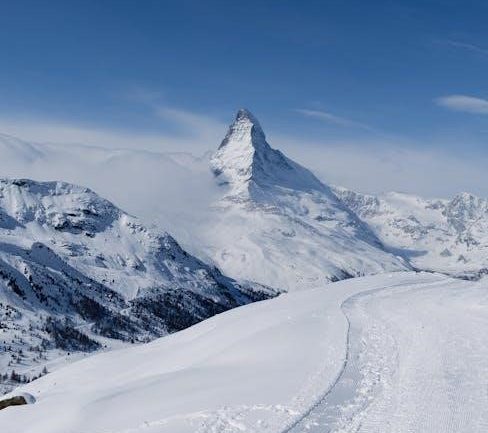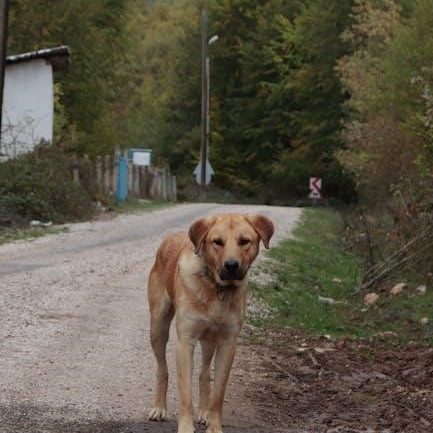The Matterhorn, standing at 4,478 meters, is one of the world’s most iconic peaks, offering a dramatic and challenging climb. Its steep, exposed routes demand experience and physical conditioning, making guided climbs highly recommended for safety and success.
Overview of the Matterhorn’s Significance
The Matterhorn, standing at 4,478 meters, is one of the most iconic and recognizable mountains globally, straddling the Swiss-Italian border. Its unique pyramid-like structure and striking beauty have made it a symbol of mountaineering and Alpine culture. As a popular yet challenging climb, it attracts adventurers worldwide, blending scenic beauty with demanding routes. The first ascent in 1865 marked a milestone in mountaineering history, cementing its reputation as a formidable peak. Today, the Matterhorn represents both a thrilling adventure and a test of endurance, offering breathtaking views and a deep connection to nature. Its significance extends beyond climbing, as it embodies the spirit of exploration and the allure of the Alps.
Why Choose a Guided Climb?
A guided climb of the Matterhorn offers unmatched safety, expertise, and logistical support, making it the best choice for climbers of all levels. Experienced guides provide invaluable insights, ensuring a safer and more enjoyable experience. They handle route navigation, risk assessment, and decision-making, allowing climbers to focus on the ascent. Guides also offer technical skills and knowledge, which are crucial for tackling the mountain’s challenging terrain. Additionally, they manage logistics like permits, accommodations, and equipment, streamlining the process. For those seeking to conquer the Matterhorn, a guided climb is the most reliable way to reach the summit while minimizing risks and maximizing the adventure.
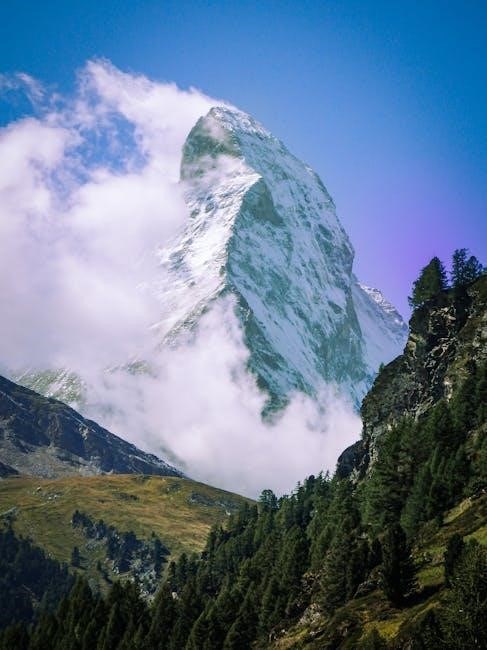
Understanding the Matterhorn
The Matterhorn is an iconic Alpine mountain, part of the Pennine range, standing at 4,478 meters. It straddles Switzerland and Italy, symbolizing mountaineering and tourism.
Geographical Location and Height
The Matterhorn is located in the Pennine Alps, straddling the border between Switzerland and Italy. It stands at an impressive height of 4,478 meters (14,692 feet) above sea level, making it one of the highest peaks in the Alps. Situated near the Swiss village of Zermatt and the Italian town of Breuil-Cervinia, the mountain is a prominent landmark in both countries. Its unique pyramidal shape and glaciated slopes make it a breathtaking sight. The Matterhorn’s location in the heart of the Alps contributes to its challenging climbing conditions and stunning vistas, attracting adventurers and mountaineers worldwide. Its proximity to Zermatt, a car-free mountain town, adds to its allure as a climbing destination.
The Hornli Ridge: The Most Popular Route
The Hornli Ridge is the most popular and frequently climbed route to the summit of the Matterhorn, favored by both experienced climbers and guided groups. This route begins at the Hornli Hut, situated at 3,260 meters, and follows a well-marked path along the ridge. While challenging, it offers breathtaking views of the surrounding Alps. The climb involves steep rock, ice, and exposed terrain, requiring a good level of physical fitness and technical skills. Despite its difficulty, the Hornli Ridge remains the most accessible route, making it a preferred choice for those aiming to conquer the Matterhorn with the guidance of experienced mountaineers.
Guided Climb Costs and Packages
Guided Matterhorn climbs vary in cost, depending on the guide service, season, and package inclusions. Prices typically range from $1,000 to $2,500 per person, covering guide fees, permits, and essential support.
Overall Cost of a Guided Matterhorn Climb
A guided Matterhorn climb typically costs between $1,000 and $2,500 per person, depending on the guide service and package details. This fee generally includes guide fees, permits, and basic support services. Prices vary based on factors like the guide’s experience, the time of year, and the number of climbers in your group. High-season climbs (July to September) tend to be more expensive due to demand. Some packages may also include additional services like gear rentals or accommodation. On average, climbers can expect to pay around $1,200 to $1,500 for a standard guided ascent. Costs may rise for private guides or extended expeditions.
What’s Included in the Price?
The cost of a guided Matterhorn climb typically includes essential services and support to ensure a safe and successful ascent. Most packages cover the expertise of an IFMGA-certified guide, who provides instruction, route planning, and safety oversight. Permits and lift tickets for accessing the mountain are usually included. Safety equipment like ropes, harnesses, and carabiners may also be provided. Some packages include accommodation in mountain huts or hotels, while others offer meal plans or transportation logistics. Gear rentals, such as crampons or ice axes, might be included or available at an additional cost. These inclusions vary by provider, so it’s important to clarify details when booking.
Additional Expenses to Consider
Beyond the guided climb package, climbers should budget for extra costs. Transportation to Zermatt, including train tickets or transfers, is typically not included. Accommodation in Zermatt before or after the climb may add to expenses, as well as meals not covered by the package. Personal climbing gear, such as boots, crampons, or clothing, may need to be purchased or rented separately. Travel insurance, which is highly recommended, is an additional cost. Other expenses might include equipment rentals, additional guide fees for smaller groups, or optional services like porter assistance. These extras can vary widely, so climbers should plan accordingly to avoid unexpected financial burdens.
Choosing the Right Guide
Selecting a certified and experienced guide is crucial for a safe and successful Matterhorn climb. Ensure your guide has extensive knowledge of the mountain’s routes and conditions.
Importance of IFMGA-Certified Guides
IFMGA-certified guides are essential for a safe and successful Matterhorn climb. These guides undergo rigorous training, ensuring they possess the expertise to navigate the mountain’s challenging terrain and unpredictable conditions.
Their certification guarantees a high level of professionalism, experience, and knowledge of the Matterhorn’s routes, weather patterns, and potential hazards. Climbing with an IFMGA-certified guide significantly reduces risks and enhances the overall experience;
They also provide valuable insights into the mountain’s history, geology, and environmental aspects, enriching your adventure. Their ability to make sound decisions in critical situations ensures a safer and more enjoyable climb.
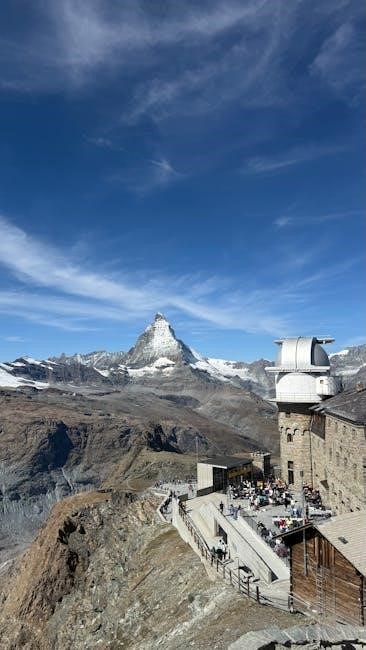
Benefits of Hiring an Experienced Guide
Hiring an experienced guide for the Matterhorn climb offers numerous benefits, ensuring a safer and more rewarding adventure. Their extensive knowledge of the mountain’s routes, conditions, and hidden dangers allows for better decision-making and navigation.
Experienced guides provide personalized advice, helping climbers improve their skills and confidence. They are well-equipped to handle emergencies and unexpected situations, minimizing risks and ensuring a smoother experience.
Additionally, guides often have local insights, sharing stories about the mountain’s history and culture, which enhances the overall adventure. Their expertise allows climbers to focus on the experience while they manage logistics and safety.
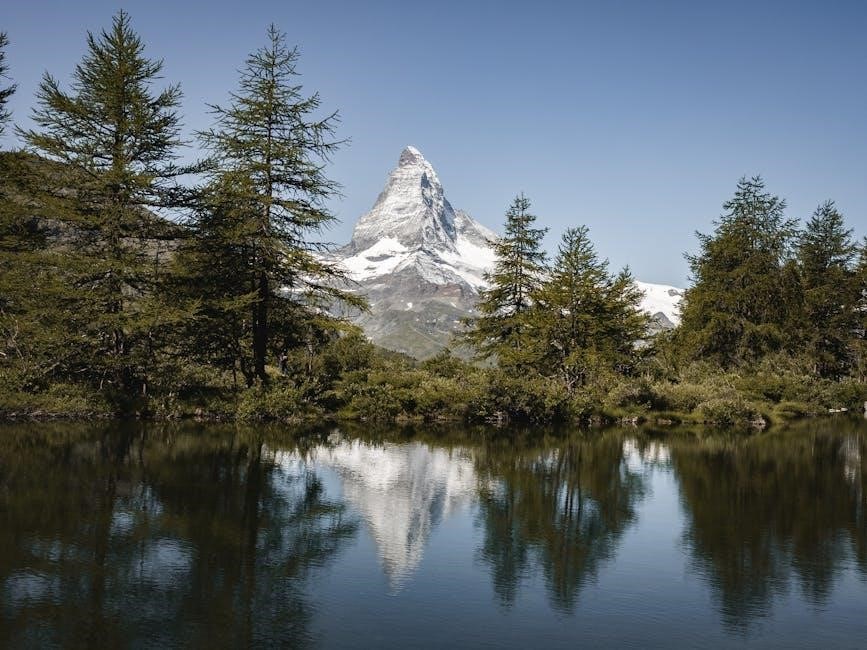
Climbing Routes and Difficulty
The Matterhorn offers several iconic routes, with the Hornli Ridge being the most popular due to its accessibility and scenic views. The climb is technically challenging, requiring strong physical endurance and advanced mountaineering skills. The terrain includes steep rock, ice, and exposed ridges, making it a formidable adventure for even experienced climbers. The difficulty lies in its unpredictable weather, high altitude, and demanding terrain, which demand careful preparation and expertise to navigate safely and successfully.
The Hornli Ridge: Details and Challenges
The Hornli Ridge is the most popular and iconic route to the Matterhorn’s summit, offering breathtaking views but posing significant challenges. Starting from the Hornli Hut at 3,260 meters, the climb spans approximately 1,300 meters of elevation gain over 4-5 hours. The route involves mixed terrain, including rock, ice, and exposed ridges, requiring a strong physical condition and advanced climbing skills. The ridge’s steepness and unpredictable weather conditions, such as snow or ice, add to the difficulty. Climbers must navigate narrow ledges, fixed ropes, and unstable rock sections, making it a mentally and physically demanding ascent. Despite the challenges, the Hornli Ridge remains a rewarding and unforgettable experience for experienced mountaineers.
Other Routes and Their Characteristics
Beyond the Hornli Ridge, the Matterhorn offers several alternative climbing routes, each with unique challenges and features. The Lion Ridge, or “Liongrat,” is a shorter but steeper route from the Italian side, known for its exposed terrain and stunning views. The Zmutt Ridge, a less crowded option, features diverse terrain, including rock, ice, and scrambling sections. The North Face, or “Nordwand,” is a highly technical and demanding route, favored by experienced climbers for its challenging ice and rock sections. These routes provide varied experiences, catering to different skill levels and preferences, while still offering the iconic Matterhorn summit experience.
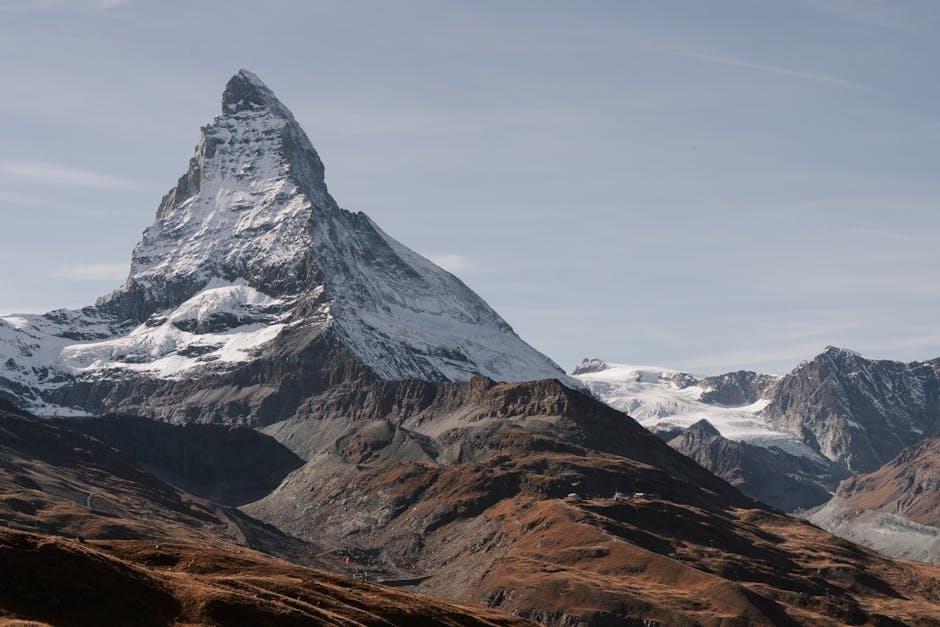
Preparation for the Climb
Preparation is key to a successful Matterhorn climb. Climbers must build strong physical conditioning, gain prior alpine experience, and ensure proper gear and mental readiness for the challenge.
Physical Conditioning Requirements
A strong physical condition is essential for a Matterhorn climb. Climbers should engage in regular cardiovascular exercises, such as running or cycling, to build endurance. Muscular strength, particularly in the legs and core, is crucial for tackling steep terrain and carrying a heavy backpack. Flexibility and balance are also important to navigate uneven surfaces. A training regimen of at least six months is recommended to ensure readiness. Acclimatization to high altitudes is vital to prevent altitude sickness. Climbers should gradually increase their physical exertion and incorporate simulated climbs to prepare for the demands of the mountain. Proper conditioning enhances safety and overall performance during the ascent.
Necessary Climbing Experience
Climbing the Matterhorn requires prior experience with challenging mountain routes. A strong foundation in alpine climbing is essential, including familiarity with steep terrain, exposed ridges, and fixed ropes. Climbers should have experience with crampons, ice axes, and glacier travel, as these skills are frequently used on the mountain. Previous ascents of similar 4,000-meter peaks or difficult multi-pitch routes are highly recommended. Comfort with heights and ability to navigate uneven, rocky terrain is crucial. While a guide provides expertise, climbers must possess basic climbing proficiency to safely tackle the Matterhorn’s demanding routes. Experience with high-altitude conditions and physical stamina are also vital for success.
Skills and Knowledge Needed
Climbing the Matterhorn demands a combination of technical skills and practical knowledge. Proficiency in using crampons, ice axes, and ropes is essential, as these tools are frequently employed on the mountain. Climbers should understand basic knots, belaying techniques, and crevasse rescue methods. Familiarity with glacier travel and navigating exposed terrain is critical. Knowledge of mountain weather patterns and how to interpret them is also vital. Physical stamina and mental resilience are necessary to handle the climb’s demanding nature. While guides provide instruction, climbers must possess a solid foundation in these skills to ensure a safe and successful ascent.
Safety Measures and Risks
The Matterhorn poses significant risks like rockfall and steep drop-offs, but expert guides minimize these dangers with proper safety equipment and secure rope systems, ensuring a safer ascent.
Common Risks Associated with the Climb
The Matterhorn climb presents several inherent risks, including steep and exposed terrain, unpredictable rockfall, and icy conditions, which can lead to slips and falls. Weather conditions such as sudden storms, strong winds, and low visibility further increase the difficulty and danger. Additionally, the high altitude poses risks of altitude sickness, while the physical demands of the climb can push even experienced climbers to their limits. These factors combine to make the Matterhorn one of the most challenging and risky climbs in the Alps, requiring careful preparation, experience, and the guidance of a skilled professional to navigate safely.
Safety Equipment and Precautions
Safety equipment is paramount for a Matterhorn guided climb. Climbers must use crampons, ice axes, and ropes to navigate icy and rocky terrain. A sturdy harness and helmet are essential to protect against falls and rockfall. Guides often carry emergency equipment, including first aid kits and communication devices. Precautions such as assessing weather conditions, using certified equipment, and staying roped up are critical. Climbers should also ensure proper footwear and layered clothing to withstand extreme cold. Additionally, guides will assess each climber’s readiness and provide detailed briefings to minimize risks. These measures help ensure a safer and more successful ascent of the Matterhorn.
Climbing Seasons and Weather
The Matterhorn climbing season typically runs from mid-July to late September. July and August offer the best conditions. Weather can be unpredictable with snowstorms, high winds, and icy temperatures, requiring careful planning and preparation.
Best Time to Climb the Matterhorn
The optimal time for a Matterhorn guided climb is between mid-July and late September. July and August are the peak months, offering relatively stable weather conditions, warmer temperatures, and solid snow-free paths. Climbers benefit from longer daylight hours during this period, improving visibility and safety. However, these months also attract larger crowds, so it’s advisable to avoid weekends if possible. Early September can offer quieter trails but with cooler temperatures. Guides typically recommend acclimatizing in lower-altitude hikes before tackling the Matterhorn to prevent altitude sickness. Booking accommodations and guides in advance is essential due to high demand during the climbing season.
Understanding Weather Conditions
The weather on the Matterhorn is notoriously unpredictable, with conditions changing rapidly due to its high altitude and geographical location. Climbers must be prepared for sudden snowstorms, high winds, and reduced visibility, even during the summer months. Temperatures can drop significantly at higher elevations, and ice formation on the route is common in the early mornings. Guides closely monitor weather forecasts to ensure safe climbing conditions. While the summer season generally offers stable weather, climbers should remain adaptable, as unexpected changes can impact the climb’s success. Understanding and respecting these weather dynamics is crucial for a safe and successful ascent.
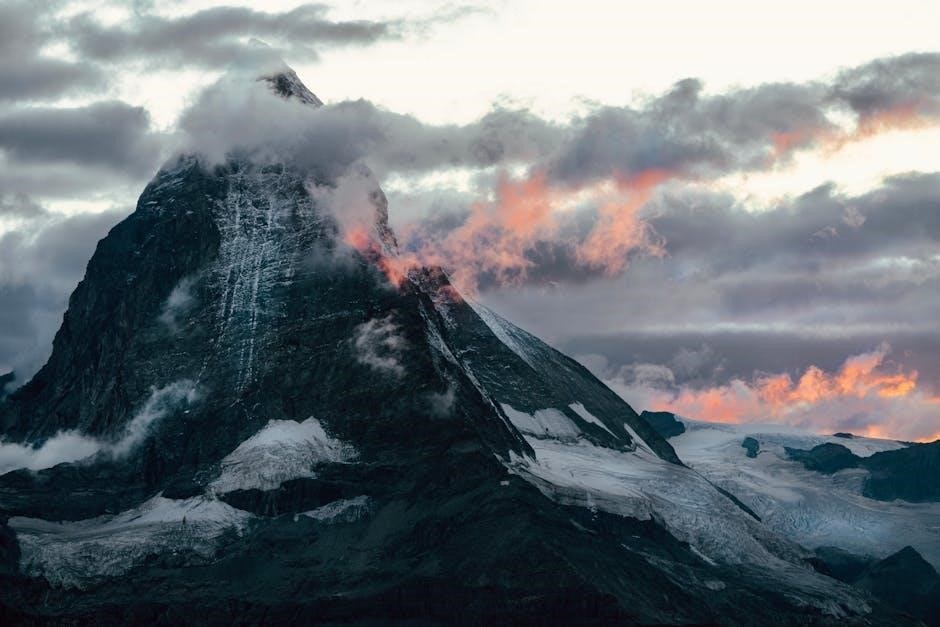
Logistics and Accommodation
Logistics involve arranging transportation to Zermatt, a car-free village, and booking accommodations ranging from hotels to mountain huts. These huts provide basic amenities and serve as a safe base for acclimatization and preparation;
Mountain Huts and Their Facilities
Mountain huts near the Matterhorn, such as the Hörnli Hut, offer essential shelter and amenities for climbers. These huts are strategically located near the base of the mountain, providing easy access to climbing routes. Facilities typically include dormitory-style accommodations, shared dining areas, and basic bathroom facilities. Meals are usually simple but nutritious, catering to climbers’ energy needs. While the huts are rustic, they provide a safe and welcoming environment for rest and preparation. Reservations are often required, especially during peak season, as these huts are critical for acclimatization and serve as a staging point for the ascent.
Transportation Options to Zermatt
Reaching Zermatt, the gateway to the Matterhorn, is straightforward via various transportation options. The village is car-free, so visitors typically arrive by train. The Glacier Express and Matterhorn Gotthard Bahn offer scenic rail connections from major Swiss cities like Zurich, Geneva, and Bern. For international travelers, the nearest airports are Zurich, Geneva, or Milan, with train transfers available. Local shuttle services and electric buses operate within Zermatt. Additionally, private transfers or heli-services can be arranged for convenience. Once in Zermatt, eco-friendly transportation options like electric buses and bicycles are available. Planning ahead is recommended, as schedules and availability vary by season.
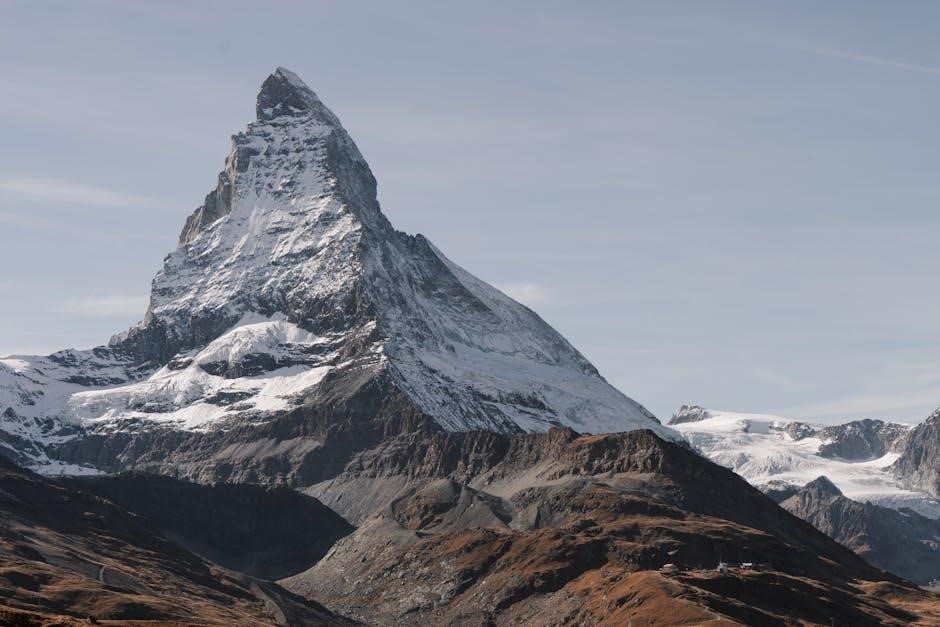
Equipment and Gear
Essential gear includes crampons, ice axes, helmets, and ropes. Quality and proper fit are crucial for safety.
Essential Climbing Gear
For a Matterhorn guided climb, essential gear includes crampons, ice axes, helmets, and ropes. Climbers also need sturdy mountaineering boots, gloves, and goggles for glacier travel. A harness, carabiners, and ascenders are vital for security on steep terrain. Additionally, a first aid kit, headlamp, and emergency shelter are critical for safety. Proper clothing layers, including a base layer, fleece, and waterproof jacket, help manage varying temperatures. Sunscreen and lip balm with SPF are necessary due to high-altitude UV exposure. Guides typically provide some equipment, but climbers should verify in advance to ensure they have everything needed for the ascent.
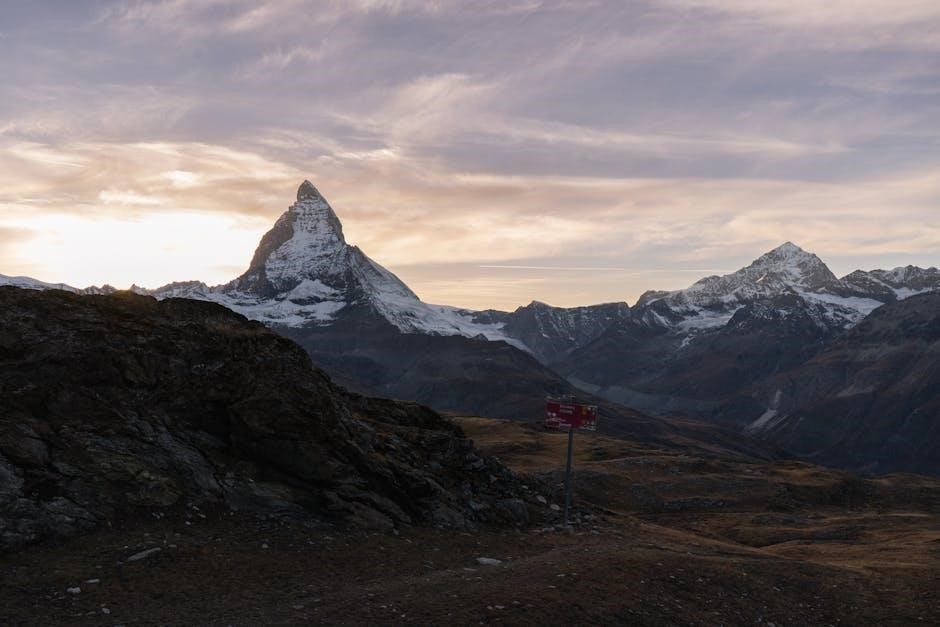
Rental Options for Equipment
Rental options for Matterhorn climbing gear are readily available in Zermatt and nearby towns. Local outdoor shops offer high-quality equipment tailored for alpine conditions, including crampons, ice axes, and harnesses. Climbers can also rent helmets, ropes, and boots, ensuring proper fit and performance. Many rental shops provide packages specifically designed for the Matterhorn ascent. It’s advisable to book rentals in advance, especially during peak season. Some guiding services include equipment rental in their packages, simplifying logistics. Renting ensures access to up-to-date gear without the burden of transporting or purchasing. This option is ideal for climbers who prefer convenience and cost-efficiency for their adventure.
Cultural and Environmental Aspects
The Matterhorn climb offers a chance to engage with Swiss and Italian mountain culture while minimizing environmental impact. Climbers are encouraged to respect local traditions and ecosystems, adhering to sustainable practices to preserve the pristine Alpine landscape for future generations.
Respecting Local Culture and Environment
Climbers on the Matterhorn must respect the rich cultural heritage of the surrounding villages, such as Zermatt, which showcase traditional Swiss Alpine architecture and vibrant local traditions. Environmental stewardship is crucial, as the Matterhorn is part of a sensitive alpine ecosystem. Guided climbs emphasize leaving no trace, minimizing waste, and avoiding damage to fragile alpine flora. Local regulations and guide expertise help ensure climbers adhere to sustainable practices, preserving the pristine beauty of the region for both locals and future visitors. By embracing these principles, climbers contribute to the long-term conservation of the Matterhorn’s iconic landscape.
Environmental Impact of Climbing
Climbing the Matterhorn can have significant environmental impacts, particularly due to erosion and waste. The high volume of climbers on routes like the Hornli Ridge leads to soil erosion and vegetation damage. Human waste and improper disposal of trash pose risks to alpine ecosystems and water sources. Littering, even small items like energy bar wrappers, accumulates and harms wildlife. To mitigate these effects, climbers are encouraged to follow sustainable practices, such as carrying out all waste and using biodegradable products. Guides often emphasize these measures to protect the fragile alpine environment and preserve the Matterhorn’s natural beauty for future generations.
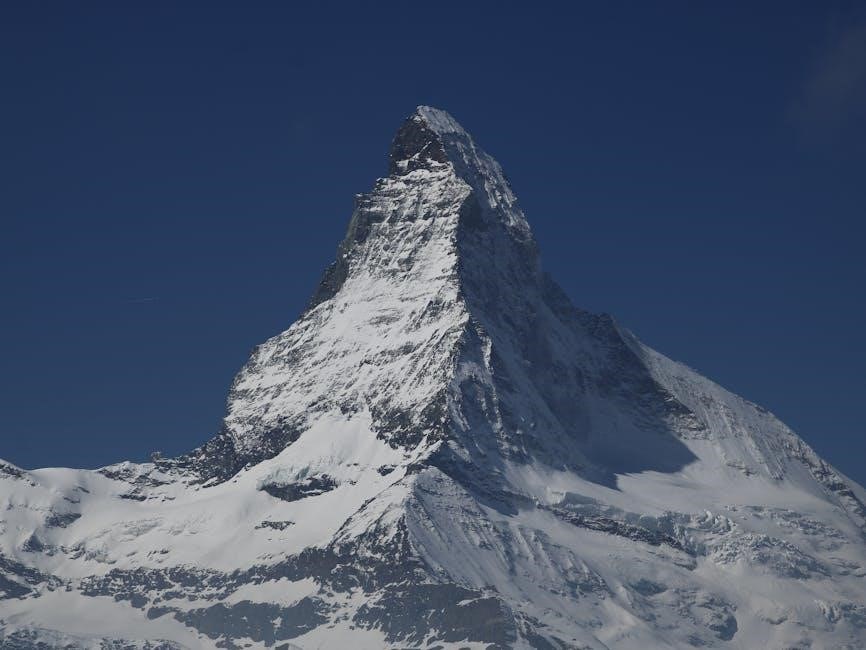
Booking and Scheduling
Booking a Matterhorn guided climb requires advance planning due to high demand. Most climbers secure spots 6–12 months prior, especially during peak season (June–September). Guides often require deposits to confirm bookings, with final payments due closer to the climb date. Scheduling depends on weather and route conditions, with most ascents starting early in the morning to avoid afternoon storms. Climbers should inquire about flexible booking policies in case of unexpected changes or cancellations.
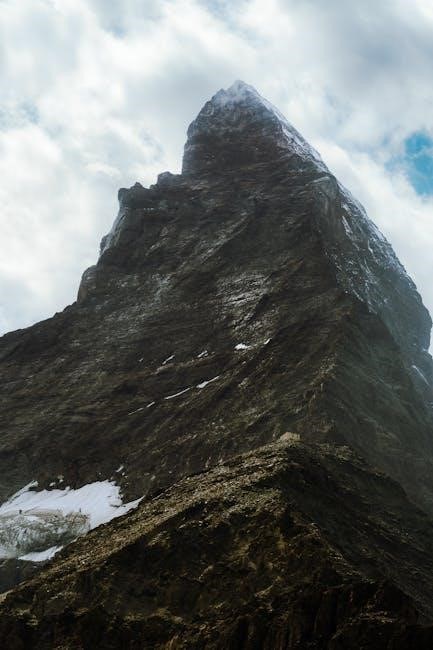
How to Book a Guided Climb
Booking a Matterhorn guided climb involves contacting certified guide services or mountaineering agencies. Start by researching IFMGA-certified guides or reputable climbing companies in Zermatt. Visit their websites or contact them directly via email or phone to inquire about availability and climb details. Most guides require an initial deposit to secure your spot, with the balance paid closer to the climb date. Ensure you review and sign a contract outlining terms, safety protocols, and cancellation policies. Be prepared to provide personal and medical information to assess your suitability for the climb. Flexibility is key, as weather conditions may require schedule adjustments.
Popular Schedules and Availability
The Matterhorn guided climb season typically runs from mid-June to late September, with peak demand in July and August. Most climbs are scheduled early in the morning to utilize favorable weather conditions. Guides often offer fixed departure dates, aligning with optimal weather forecasts. Availability can be limited during peak weeks, so early booking is essential. Weekends and holidays tend to fill up quickly. Climbers should plan flexibility in their schedule, as weather-related delays are common. Many guides also offer private climbs, which can be tailored to your preferences. Always confirm availability directly with your guide or agency, as schedules can vary based on conditions.
A Matterhorn guided climb offers an unforgettable experience, blending breathtaking views with personal achievement. It’s more than a climb—it’s a journey that leaves lasting memories and inspiration.
Final Thoughts on the Matterhorn Guided Climb
Embarking on a Matterhorn guided climb is a life-changing adventure that combines breathtaking Alpine scenery with a thrilling physical and mental challenge. While the climb demands dedication and preparation, the sense of accomplishment upon reaching the summit is unparalleled. The expertise of certified guides ensures safety and confidence throughout the journey. The Matterhorn is not just a mountain; it’s a symbol of perseverance and beauty. For those willing to embrace the challenge, the rewards are immeasurable. Remember to respect the mountain’s power and the environment, as you create unforgettable memories. Let the Matterhorn inspire you to push your limits and explore the extraordinary.
Encouragement to Embark on the Adventure
If you’re considering a Matterhorn guided climb, remember that this adventure is a once-in-a-lifetime opportunity to push your limits and experience breathtaking beauty. The challenge is significant, but the rewards are even greater. Imagine standing atop one of the most iconic mountains in the world, feeling an overwhelming sense of pride and accomplishment. With proper preparation and the guidance of an expert, the climb is achievable for those willing to embrace the effort. Don’t let fear hold you back—embrace the adventure, immerse yourself in nature’s grandeur, and create memories that will inspire you for years to come. The Matterhorn awaits your courage and determination.
